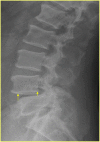The effects of anterior vacuum disc on surgical outcomes of degenerative versus spondylolytic spondylolisthesis: at a minimum two-year follow-up
- PMID: 25277044
- PMCID: PMC4201703
- DOI: 10.1186/1471-2474-15-329
The effects of anterior vacuum disc on surgical outcomes of degenerative versus spondylolytic spondylolisthesis: at a minimum two-year follow-up
Abstract
Background: The vacuum phenomenon within the intervertebral disc usually represents disc degeneration. There are no reports in the English literature that focus on the effect of an anterior vacuum disc on surgical outcome of same-segment spondylolisthesis.
Methods: Patients with degenerative spondylolisthesis (DS) or isthmic spondylolisthesis (IS) who underwent a spinal surgery between January 2005 and December 2006 were reviewed. Patients who met certain criteria, including (1) only mono-segment spondylolisthesis, (2) gas air within the disc space of the spondylolisthesis segment on preoperative radiographs, (3) having received posterior decompression, posterior pedicle screw fixation, and posterolateral fusion, and (4) at least 12 months of follow-up radiographs available to define the posterolateral fusion rate, were enrolled into the study. Four radiographic parameters (disc height, translation, intradiscal angle, segmental angle) were assessed. Two-year postoperative radiographs were used to determine whether the posterolateral segment was fused or not. Clinical outcome and complications during the follow-up period were documented.
Results: Incidence of the disc vacuum phenomenon was significantly higher in the IS group than in the DS group (p < 0.001). The IS group had more listhesis and a narrower disc height on preoperative static radiographs; however, the DS group had a more prominent angle and listhesis change in preoperative dynamic variables. The posterolateral fusion rate was significantly higher in the IS group (p = 0.019). The preoperative Oswestry Disability Index (ODI) score, the final ODI, and the ODI difference were similar between groups. More excellent and good results were seen in the IS group. Besides, better final ODI and results were seen in the bilateral fusion group than in the nonfusion group.
Conclusion: The disc vacuum phenomenon is not equal to anterior instability absolutely. Determination of stability or instability in a vacuum disc should be considered by a combination of dynamic radiographs. In the present study, vacuum discs in the DS group showed more instability and a higher posterolateral pseudoarthrosis rate.
Figures




References
Pre-publication history
-
- The pre-publication history for this paper can be accessed here:http://www.biomedcentral.com/1471-2474/15/329/prepub
Publication types
MeSH terms
LinkOut - more resources
Full Text Sources
Other Literature Sources
Medical
Miscellaneous

